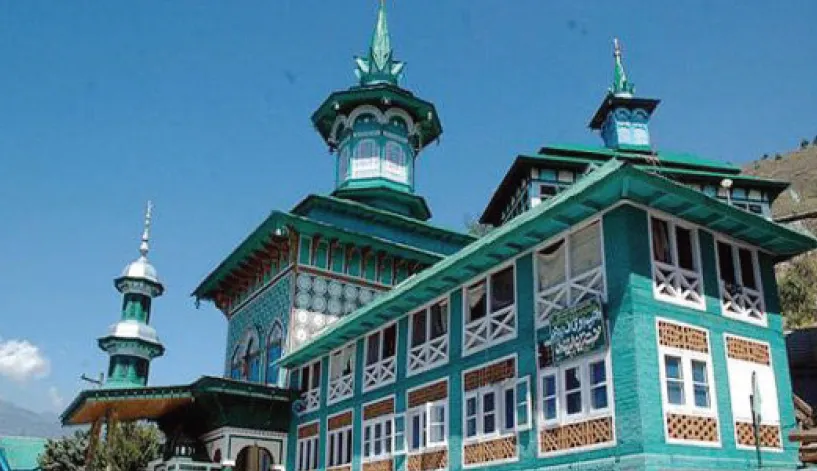Baba Zain ud Din Reshi, more popularly known by his other names, like Zain Shah Sahib, Zain Moet and Sakhi Zain ud Din of Ashmuqam lived in 15th century AD. He was the most celebrated saint of the famous Reshi order of this land.
He is one among the founder saints of the Kashmiri Rishi order and is remembered for his generosity. His devotees in South Kashmir believe that even today no one returns empty handed from his Dargah, which is magnificently located in the lap of the rising hill in the glorious Lidder valley at Ashmuqam.
The symbol of the wonderful spiritual legacy, communal harmony and masterpiece of Kashmiri Rishi order architecture, the shrine of the saint has been attracting its devotees from the distant corners of the state all over the year. But a huge rush of devotees is seen during the urs days, from the 16th of Zeth of the local Calendar, which corresponds to the first week of April.
The favorite shrine of Kashmiri boatmen, shepherds and tribal communities of Pirpanchal and Chenab valleys, his devotees and followers throng to this glorious site from far off lands of Jammu and Kashmir including Rajouri and Poonch districts.
The festival is always celebrated with religious fervour and cultural gaiety in the entire south Kashmir. The most attractive and distinctive characteristic of the Urs is of the lightings locally called Zool or Phrow.
The entire site of the Rishi Dargh is illuminated with traditionally lighted torches which gives its devotees a very different feeling. These torches are made of deodar and Kail wood. In practice, small pieces of wood are first bundled and fixed on the tip of a long wooden piece. The devotees holding the torches, mashals, in their hands throng the shrine in processions, raising slogans,‘ Shah Shah Zain Ud Din Shah’ Wali Wali Zain Ud Din Wali.
They run in chores jumping, similar to the Sufi whirling. These lit up wooden torches is called Zool. It starts with sun down and is over soon after evening prayers. The entire lighting scene, slogans, and Sufi whirling gives a different spiritual feeling. The philosophy behind observing this Rishi ritual is to symbolize triumph over evil. It is not only here at the Dargh, but the ritual of lighting torches ( Zool) is held all over the area where the devotees of the saint still follow this tradition.
In the Rishi order, Baba is recorded as the second dreariest friend ( Khaliph) of Shiekh Noor ud Din Noorani. His Rishi journey has started from Bounderkote, Kishtwar, where he was born in a Hindu Rajput family and was named Zai Singh. In search of his Rishi path he travelled from Kishtwar to Kashmir valley to meet the Rishies of Kashmir.
During the search he met Nundreshi, the patron Rishi saint and entered into Rishi fold at his hands. He was asked to report at the cave of Aishmuqam where he could meditate for search of the truth. When he reached the cave, he saw it was filled with snakes. Baba told them that this cave had now been allotted to me so please leave the spot. Snakes left the cave for the Baba where he meditated for years and attained the enlightenment.
He is learnt to have left for heavenly abode at the site, however, details about his funeral rites are shadowed in mystery. Traditions preserved here say that when his body was put into the coffin, it disappeared. Later Baba came into dream of one of his friends and told him to dig the grave where you had kept my coffin. The next day same was done.
Baba abstained from other things and worshiped God. He searched for truth and attained the favors of the Creator in the green forests of Ahmuqam. In his routine diet, he followed his Peer (spiritual guide) who took forest vegetation Vopal Hakh. At the shrine of Zain-ud-Din Rishi is preserved a relic, called wooden-bread. It is recorded that the saint used to tie it with his belly when he had nothing to eat.
The saint during life time performed wonderful spiritual miracles which are not only preserved in the local folklore and Rishi literature but the mainstream historians have also mentioned those in their respective works. Rishinama, Tarikh e Hassan and several European travelers have also recorded the works and teachings of this saint.
Sir Walter R Lawance, in Valley of Kashmir, has also recorded one of his spiritual miracles. He writes that Zian ud Din was a Khalifa of Shiekh Noor Ud Din and men of his shrine wear a peculiar headdress, with zigzag bars of color. Once, one of the servants of his Khanqah was sent out by Zain Shah for some work.
He was captured by the officials for forced labor. Zain Shah, in his anger, caused the Lidder River to dry up, there by inflicting great loss on the rice crops. The king of the Kashmir, on hearing this, proceeded to Ashmuqam and in order to prevent the similar mistakes occurring in the future suggested that the Zain Shah’s followers should wear a distinctive headdress. Till recent times the Rishi attendants were seen wearing this type of headdress which locally was known as taser.
The shrine itself symbolises the graceful wooden architecture of Kashmir where the tombs of the saints are magnificently adorned with classical wooden ornamentations. The superstructure has got the pyramidal type of roofing in four tiers where each successive tier diminishes in size and finally gives place to the rising steeple of the pagoda order.
Of its superb locations, wooden architectural significance, spiritual legacy, centre for communal harmony and mysteries associated with this site, the place served as one of the main destinations of heritage tourist traffic, not only for locals but for outside tourists as well. The shrine has also figured in several Hollywood and Bollywood documentaries and movies.
The writer is a senior archaeologist and author.







